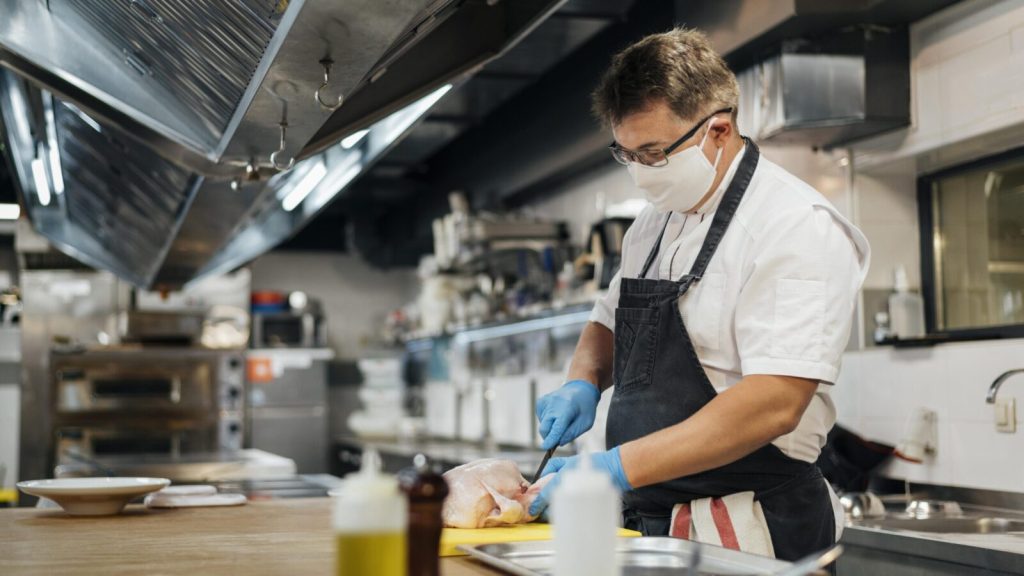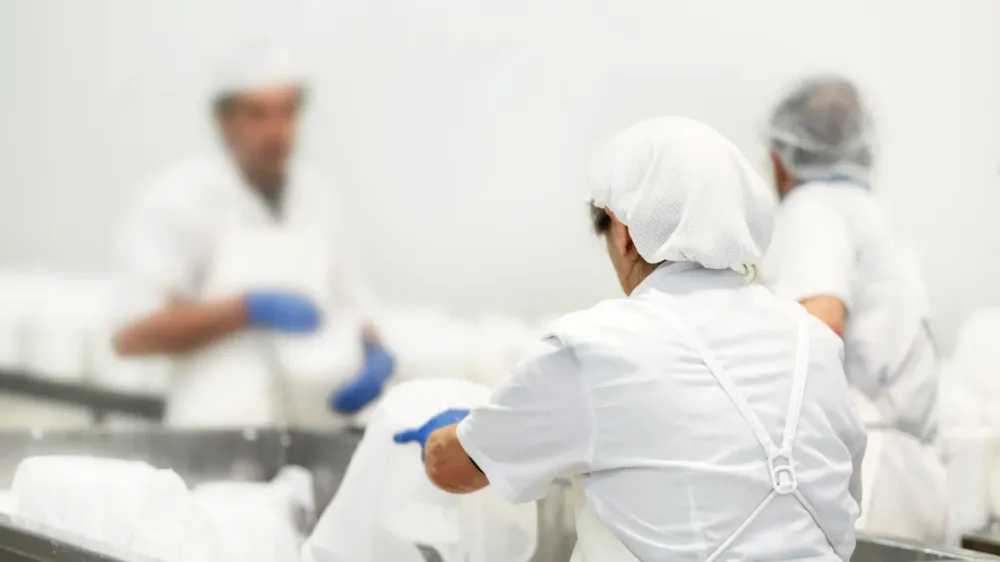
Essential PPE in the Food Industry: What You Need to Know
Overwhelmed by PPE options for food safety? Master your PPE selection for food workers safety with these practical tips.

Get 20€ off on your first order!
Whether you’re an industrial buyer for a food manufacturing plant or a restaurateur, you know the importance of using quality supplies and equipment to ensure the safety of both your workers and products.
In this guide, we will provide an overview of the different types of Personal Protective Equipment (also known as PPE) commonly used in food manufacturing to protect workers and prevent food contamination.
These include among others protective gloves, aprons, hairnets, face masks, eye & ear protection, and safety shoes.
We will discuss the importance of PPE in the food industry, its use cases, and tips for maintaining and using your PPE safely.
So, here are all the categories of personal protective equipment we’re going to cover:
 Personal protective equipment (PPE) in the food industry is crucial to protect workers and prevent food contamination.
Personal protective equipment (PPE) in the food industry is crucial to protect workers and prevent food contamination.
Head and body protection are the first essential components of personal protective equipment in food manufacturing, and they commonly include hairnets, aprons, and sleeves.
These items are designed to:
Let’s take a closer look at them:
If correctly worn these PPE supplies are effective in both shielding workers and preventing food contamination. However, always remember, proper maintenance of head and body protection is also essential. Items such as hairnets and sleeves should be replaced after each use, while non-disposable aprons should be regularly cleaned and inspected for signs of wear or damage.
If any defects or issues are found, the PPE should be immediately replaced to ensure continued protection.
Protective gloves play a crucial role in protecting workers from injuries and preventing food contamination.
Workers in food manufacturing facilities are exposed to various hazards such as sharp objects, hot surfaces, and chemicals.
There are different types of gloves available for workers in food manufacturing facilities, including latex, vinyl, and nitrile gloves.
Latex gloves are flexible and provide a high level of dexterity, making them ideal for tasks that require fine motor skills, such as food preparation. However, some workers may be allergic to latex, so vinyl or nitrile gloves are a suitable alternative. Vinyl gloves are also lightweight and comfortable to wear, while nitrile gloves are generally more durable and better resistant to some chemicals.
In addition to protecting workers, gloves also help prevent food contamination. Food manufacturing supplies, such as food processing equipment, food preparation equipment, and food packaging equipment, can harbour harmful microorganisms that can cause foodborne illness.
Workers can inadvertently transfer these microorganisms to food products through their hands, leading to contamination. By wearing gloves, workers can prevent direct contact between their hands and food, reducing the risk of contamination.
However, it’s important to note that gloves are not a foolproof solution. Gloves can become contaminated during use, and if not changed regularly, they can transfer contaminants from one surface to another. Workers should always wash their hands before and after using gloves and change gloves frequently to prevent cross-contamination.
And lastly, always be mindful, it’s crucial to use the appropriate protective gloves for the specific tasks being performed.
For example, employees working with hot liquids or sharp objects should wear heat-resistant gloves or cut-resistant gloves, respectively. Similarly, employees working with chemicals or cleaning products should wear chemical-resistant gloves, aprons, and other protective gear. Using the appropriate PPE is critical to ensuring employee safety and avoiding injury or contamination.
You can read more on how to select the best protective equipment for your industrial settings in our previous blog post: Keeping Workers Safe: how to select the right Personal Protective Equipment (PPE).
Eye and ear protection also belong to the list of essential personal protective equipment in food manufacturing.
Food processing plants present many hazards that could result in ear or eye injuries, including loud noises and flying debris. So, without the proper protective gear, workers are at risk of hearing loss, vision damage, or other types of injury.
It’s therefore critical to provide appropriate eye and ear protection like:
Like with all PPE supplies, it’s essential to follow all the right procedures when using and maintaining eye and ear protection in food manufacturing.
Workers should always ensure that their eye and ear protection fits properly, is clean and well-maintained, and is replaced whenever damaged or worn out. Additionally, it’s crucial to conduct regular inspections of the protection to ensure there are no cracks or other signs of damage.
If you want to read more on how to properly use, maintain, and dispose of your PPE supplies, read our previous blog post: From Usage to Disposal: A Complete Guide to PPE Procedures.
 Browse our extensive catalogue of PPE supplies for food manufacturing!
Browse our extensive catalogue of PPE supplies for food manufacturing!
Respiratory Protection is crucial in the food manufacturing industry to prevent the inhalation of harmful particles, dust, and other contaminants that could cause respiratory illnesses.
On top of that, workers can inadvertently exhale microorganisms that can contaminate food products. So, the use of face masks can prevent workers from directly exhaling onto food products, reducing the risk of contamination.
There are different types of respiratory protection used in food manufacturing, including masks and respirators.
Masks are designed to provide protection against large particles, whereas respirators protect against smaller particles, such as dust and fumes. Additionally, face masks can also prevent workers from touching their noses or mouth, further reducing the risk of contaminating food products with bacteria or other microorganisms.
On the other hand, another common type of respiratory protection used in food manufacturing facilities is the N95 respirator mask. N95 masks are designed to filter out at least 95% of airborne particles, including dust, bacteria, and viruses. They are particularly useful in preventing the spread of airborne contaminants in confined spaces such as walk-in freezers, where fumes and vapours can accumulate.
However, it’s important to note that wearing a mask alone is not enough to ensure worker safety and prevent food contamination.
Face masks and respirators must be worn, maintained, and disposed of correctly. So, each worker should always make sure that the mask or respirator fits properly, and is kept clean and well-maintained.
When sourcing the right PPE supplies for your food manufacturing plant or restaurant, you should never neglect foot protection.
Workers in the food industry are exposed to slippery floors, sharp objects, and heavy equipment, making it crucial to wear appropriate safety shoes.
Footwear used in food manufacturing should be designed with safety and hygiene in mind. One common option is slip-resistant shoes that provide stability and prevent slips and falls. This safety footwear is typically made of waterproof materials and has a steel toe for added protection against heavy equipment or falling objects.
Another type of foot protection that may be required in food manufacturing is overshoes, which are typically worn over regular shoes or boots to prevent the spread of contaminants from outside the facility. These overshoes are designed to be disposable and are made of materials that are easy to clean and sanitize.
Of course, as with all PPE supplies, to ensure the effectiveness of food protection, it is important for workers to properly use and maintain it. This includes regularly cleaning and sanitizing safety shoes, inspecting them for damage or wear, and replacing them as needed.
 Browse our extensive catalogue of PPE supplies for food manufacturing!
Browse our extensive catalogue of PPE supplies for food manufacturing!
All in all, Personal Protective Equipment (also known as PPE) is essential in food manufacturing facilities to protect workers and prevent food contamination.
The use of appropriate PPE for the specific tasks being performed is critical, but don’t forget that proper maintenance and replacement of PPE supplies are just as important.
This guide was designed to help you ensure that your food manufacturing facility is equipped with the necessary PPE supplies to protect workers and produce safe and high-quality food products.
Next, check out our extensive catalogue of PPE supplies for food manufacturing from Europe’s top suppliers – or click on the following PPE product categories:
Thank you! You've signed up for our newsletter.



















Overwhelmed by PPE options for food safety? Master your PPE selection for food workers safety with these practical tips.

Struggling to maintain clear vision in demanding environments? This guide is here to help. By the end, you’ll know exactly...

Electricians across Europe face unique challenges that require reliable safety glasses to ensure both protection and efficiency. Whether safeguarding against...

Overwhelmed by PPE options for food safety? Master your PPE selection for food workers safety with these practical tips.

Struggling to maintain clear vision in demanding environments? This guide is here to help. By the end, you’ll know exactly...

Electricians across Europe face unique challenges that require reliable safety glasses to ensure both protection and efficiency. Whether safeguarding against...
Get 20€ off on your first order!
Save 30% by buying directly from brands, and get an extra 10€ off orders over €100
Save 30% by buying directly form brands, and get an extra 10€ off orders over €100